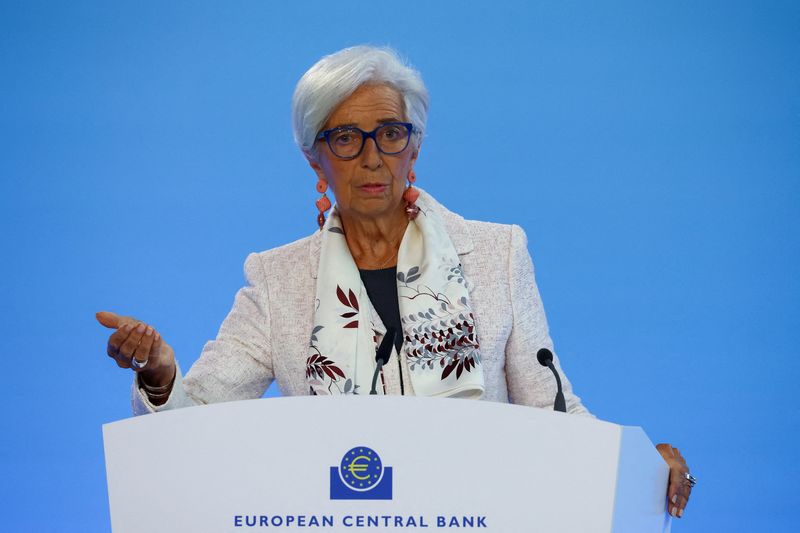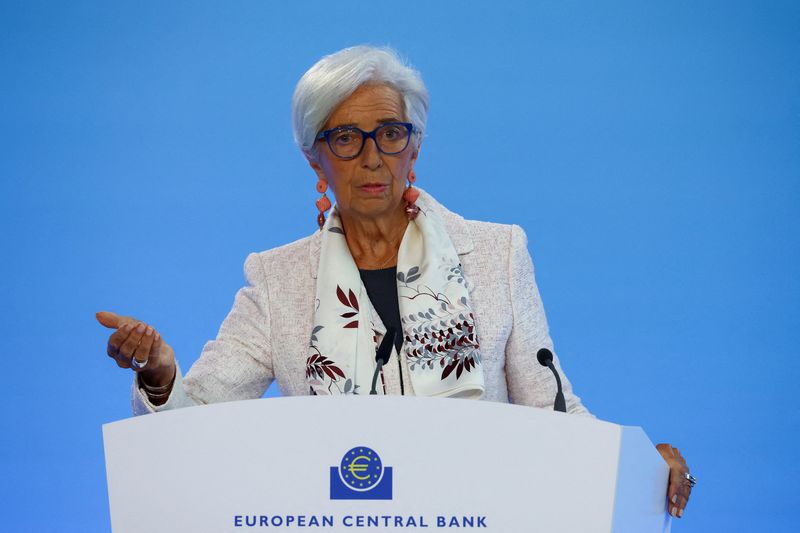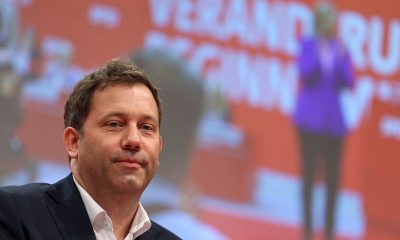Economy
Lagarde seized ECB colleagues’ handsets to prevent leaks


© Reuters. FILE PHOTO: European Central Bank (ECB) President Christine Lagarde speaks to the media following the Governing Council’s monetary policy meeting at the ECB headquarters in Frankfurt, Germany, July 27, 2023. REUTERS/Kai Pfaffenbach/File Photo
By Balazs Koranyi and Francesco Canepa
FRANKFURT/SANTIAGO DE COMPOSTELA (Reuters) – European Central Bank President Christine Lagarde seized the mobile phones of her fellow policymakers at this week’s meeting and rebuked them for leaking crucial information ahead of a policy decision, two sources told Reuters.
The unprecedented move is the boldest step that Lagarde has taken to stop information leaking out from the Governing Council, an issue that has plagued her presidency as well that of her predecessor, Mario Draghi.
The 26 members of the Governing Council were told to hand over their mobile phones on Wednesday, the first day of the meeting, as policymakers were about to pick Claudia Buch as the ECB’s top banking supervisor, the sources familiar with the matter said.
The handsets were returned after Buch’s nomination as chair of the Single Supervisory Board, which oversees more than a hundred of the euro zone’s biggest lenders, had been announced, the sources added.
The decision was taken because the choice in 2018 of the current chair, Andrea Enria, appeared in the media before the official release, the sources said.
An ECB spokesperson declined to comment.
Lagarde’s move came a day after Reuters exclusively revealed the ECB would raise a key inflation forecast this week, which paved the way for an interest rate hike on Thursday.
Most economists and traders had expected the ECB to keep rates on hold, but many changed their view after the Reuters report was published late on Tuesday.
Lagarde stigmatised the leak at the start of the two-day meeting, a criticism that was echoed by several colleagues.
DIVIDED
Lagarde inherited a divided Governing Council from Draghi, who had alienated so called hawks in the euro zone’s north with his ultra-easy monetary policy and abrasive management style.
She has steadily tried to create a more harmonious atmosphere and several sources agree she has largely succeeded.
Ironically, her efforts were helped by painfully high inflation over the past two years, which reduced the room for dissent and effectively forced the ECB to embark on a streak of interest rate hikes.
But as borrowing costs were pushed higher, more policymakers expressed reservations about further hikes, the sources said.
Lagarde said on Thursday the latest increase was backed by “a solid majority of the governors”, compared to all of them for the previous rise in July and a “very, very broad consensus” a month earlier.
Lagarde has spared no effort in trying to woo her colleagues.
Weeks into her term in 2019, they gathered at a German mountain castle where she pledged to spend more time listening, and not to front-run decisions before policymakers had weighed in, as Draghi was often accused of doing.
In return, she asked for governors to stop trashing policy decisions once taken, keep internal disputes out of the media and put their phones away while colleagues were speaking.
She also set informal guidelines last year instructing colleagues to present the majority view to the public after the ECB’s policy decisions, which are published on Thursdays, and hold back “personal” views until the following Monday.
(Writing By Francesco Canepa; Editing by Mike Harrison)
Economy
Russian central bank says it needs months to make sure CPI falling before rate cuts -RBC


© Reuters. Russian Central Bank Governor Elvira Nabiullina attends a news conference in Moscow, Russia June 14, 2019. REUTERS/Shamil Zhumatov/File Photo
MOSCOW (Reuters) – Russia’s central bank will need two to three months to make sure that inflation is steadily declining before taking any decision on interest rate cuts, the bank’s governor Elvira Nabiullina told RBC media on Sunday.
The central bank raised its key interest rate by 100 basis points to 16% earlier in December, hiking for the fifth consecutive meeting in response to stubborn inflation, and suggested that its tightening cycle was nearly over.
Nabiullina said it was not yet clear when exactly the regulator would start cutting rates, however.
“We really need to make sure that inflation is steadily decreasing, that these are not one-off factors that can affect the rate of price growth in a particular month,” she said.
Nabiullina said the bank was taking into account a wide range of indicators but primarily those that “characterize the stability of inflation”.
“This will take two or three months or more – it depends on how much the wide range of indicators that characterize sustainable inflation declines,” she said.
The bank will next convene to set its benchmark rate on Feb. 16.
The governor also said the bank should have started monetary policy tightening earlier than in July, when it embarked on the rate-hiking cycle.
Economy
China identifies second set of projects in $140 billion spending plan


© Reuters. FILE PHOTO: Workers walk past an under-construction area with completed office towers in the background, in Shenzhen’s Qianhai new district, Guangdong province, China August 25, 2023. REUTERS/David Kirton/File Photo
SHANGHAI (Reuters) – China’s top planning body said on Saturday it had identified a second batch of public investment projects, including flood control and disaster relief programmes, under a bond issuance and investment plan announced in October to boost the economy.
With the latest tranche, China has now earmarked more than 800 billion yuan of its 1 trillion yuan ($140 billion) in additional government bond issuance in the fourth quarter, as it focuses on fiscal steps to shore up the flagging economy.
The National Development and Reform Commission (NDRC) said in a statement on Saturday it had identified 9,600 projects with planned investment of more than 560 billion yuan.
China’s economy, the world’s second largest, is struggling to regain its footing post-COVID-19 as policymakers grapple with tepid consumer demand, weak exports, falling foreign investment and a deepening real estate crisis.
The 1 trillion yuan in additional bond issuance will widen China’s 2023 budget deficit ratio to around 3.8 percent from 3 percent, the state-run Xinhua news agency has said.
“Construction of the projects will improve China’s flood control system, emergency response mechanism and disaster relief capabilities, and better protect people’s lives and property, so it is very significant,” the NDRC said.
The agency said it will coordinate with other government bodies to make sure that funds are allocated speedily for investment and that high standards of quality are maintained in project construction.
($1 = 7.1315 renminbi)
Economy
Russian central bank says it needs months to make sure CPI falling before rate cuts -RBC


© Reuters. Russian Central Bank Governor Elvira Nabiullina attends a news conference in Moscow, Russia June 14, 2019. REUTERS/Shamil Zhumatov/File Photo
MOSCOW (Reuters) – Russia’s central bank will need two to three months to make sure that inflation is steadily declining before taking any decision on interest rate cuts, the bank’s governor Elvira Nabiullina told RBC media on Sunday.
The central bank raised its key interest rate by 100 basis points to 16% earlier in December, hiking for the fifth consecutive meeting in response to stubborn inflation, and suggested that its tightening cycle was nearly over.
Nabiullina said it was not yet clear when exactly the regulator would start cutting rates, however.
“We really need to make sure that inflation is steadily decreasing, that these are not one-off factors that can affect the rate of price growth in a particular month,” she said.
Nabiullina said the bank was taking into account a wide range of indicators but primarily those that “characterize the stability of inflation”.
“This will take two or three months or more – it depends on how much the wide range of indicators that characterize sustainable inflation declines,” she said.
The bank will next convene to set its benchmark rate on Feb. 16.
The governor also said the bank should have started monetary policy tightening earlier than in July, when it embarked on the rate-hiking cycle.

 Forex3 years ago
Forex3 years agoForex Today: the dollar is gaining strength amid gloomy sentiment at the start of the Fed’s week

 Forex3 years ago
Forex3 years agoUnbiased review of Pocket Option broker

 Forex3 years ago
Forex3 years agoDollar to pound sterling exchange rate today: Pound plummeted to its lowest since 1985

 Forex3 years ago
Forex3 years agoHow is the Australian dollar doing today?

 Cryptocurrency3 years ago
Cryptocurrency3 years agoWhat happened in the crypto market – current events today

 World3 years ago
World3 years agoWhy are modern video games an art form?

 Commodities3 years ago
Commodities3 years agoCopper continues to fall in price on expectations of lower demand in China

 Economy3 years ago
Economy3 years agoCrude oil tankers double in price due to EU anti-Russian sanctions





























